¿Quieres restablecer tu contraseña de WordPress usando phpMyAdmin?
Si no se ha podido restablecer la contraseña de WordPress, existe una forma de hacerlo directamente en la base de datos de WordPress mediante phpMyAdmin.
En este artículo, le mostraremos cómo restablecer fácilmente una contraseña de WordPress desde phpMyAdmin.
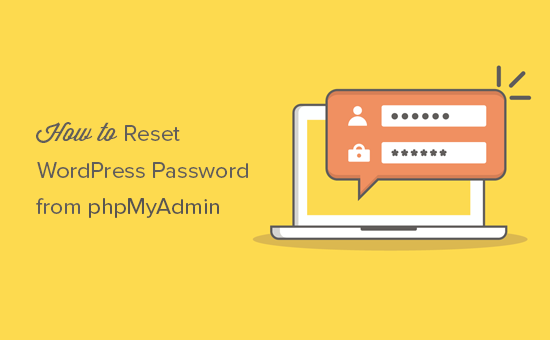
¿Por qué restablecer una contraseña de WordPress desde phpMyAdmin?
WordPress hace que sea muy fácil recuperar una contraseña perdida.
Sólo tiene que ir a la pantalla de acceso de su sitio web de WordPress y hacer clic en el enlace “¿Ha perdido su contraseña?”.
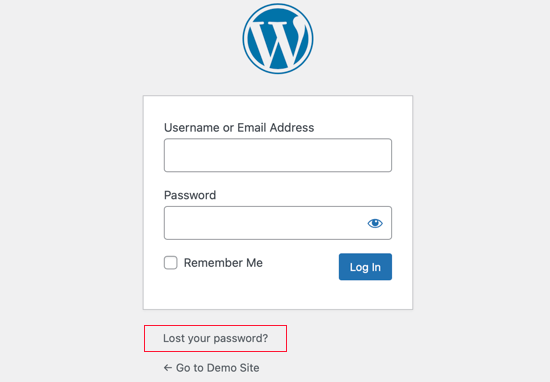
Al hacer clic en el enlace, accederá a la página de restablecimiento de contraseña. Una vez que introduzca su nombre de usuario o dirección de correo electrónico, WordPress le enviará un enlace para restablecer la contraseña a la dirección de correo electrónico asociada.
Sin embargo, si no tiene acceso a esa dirección de correo electrónico o su sitio de WordPress no envía ningún correo electrónico, no podrá restablecer su contraseña.
En tal situación, tendrá que restablecer su contraseña de WordPress directamente en la base de datos. La forma más sencilla de hacerlo es utilizando phpMyAdmin.
Dicho esto, veamos cómo restablecer fácilmente una contraseña de WordPress desde phpMyAdmin.
Cómo restablecer una contraseña de WordPress desde phpMyAdmin
Si no desea ver el tutorial en vídeo, puede seguir leyendo la versión en texto que figura a continuación.
En primer lugar, debe acceder al Escritorio de WordPress de su cuenta de alojamiento. A continuación, debe navegar hasta la sección Bases de datos, donde puede hacer clic en el icono phpMyAdmin.
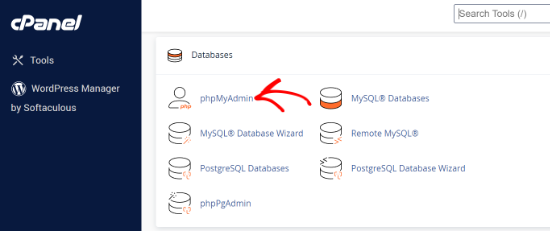
Esto iniciará la aplicación phpMyAdmin.
Aquí debe seleccionar su base de datos de WordPress en el panel izquierdo.
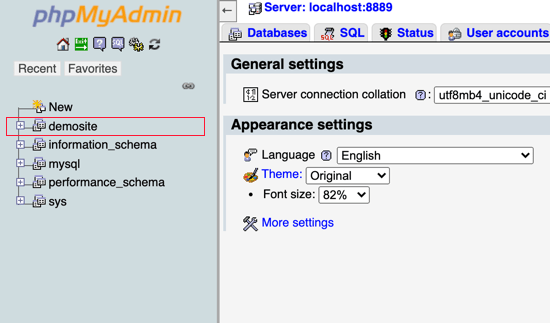
Ahora verá el anuncio / catálogo / ficha en su base de datos de WordPress.
Debe buscar la tabla wp_users en esta lista y hacer clic en el enlace “Examinar” situado a su lado.
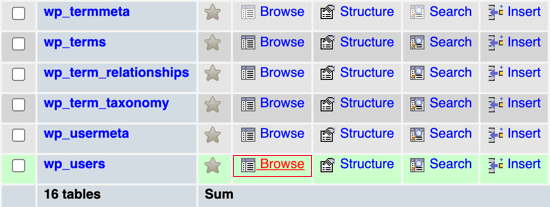
Nota: Los nombres de tabla en su base de datos de WordPress pueden tener un prefijo diferente al que mostramos en nuestra captura de pantalla. Cambiar los prefijos de las tablas puede mejorar la seguridad de tu sitio WordPress.
Ahora verá las filas de su tabla de usuarios de WordPress. Siga adelante y haga clic en el botón de edición al lado del nombre de usuario cuya contraseña desea cambiar.
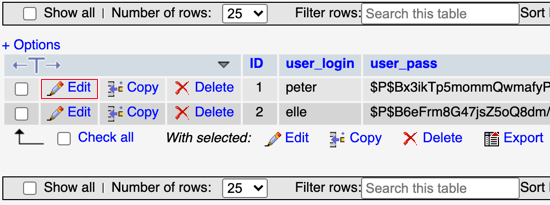
PhpMyAdmin le mostrará un formulario con todos los campos de información del usuario.
Deberá borrar el valor del campo user_pass y sustituirlo por su nueva contraseña. En la columna de función, seleccione MD5 en el menú desplegable y, a continuación, haga clic en el botón Ir situado en la parte inferior del formulario.
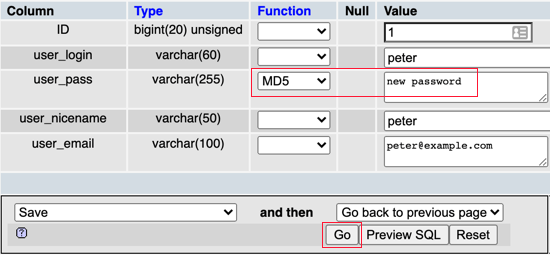
Su contraseña se cifrará utilizando el hash MD5 y luego se almacenará en la base de datos.
¡Enhorabuena! Has cambiado correctamente tu contraseña de WordPress usando phpMyAdmin.
Algunos de ustedes se preguntarán por qué hemos seleccionado el hash MD5 para cifrar la contraseña. Anteriormente WordPress utilizaba el hash MD5 para cifrar las contraseñas, pero desde WordPress 2.5 utiliza tecnologías de cifrado más potentes.
Sin embargo, WordPress sigue reconociendo MD5 para proporcionar compatibilidad con versiones anteriores. Tan pronto como acceda usando una cadena de contraseña almacenada como un hash MD5, WordPress la cambiará automáticamente para usar los algoritmos de cifrado más recientes.
Guías de expertos sobre contraseñas en WordPress
Ahora que ya sabes cómo restablecer una contraseña de WordPress desde phpMyAdmin, quizás quieras ver otros artículos relacionados con las contraseñas en WordPress.
- Cómo cambiar la contraseña en WordPress (Guía para principiantes)
- Cómo restablecer las contraseñas de todos los usuarios en WordPress
- Cómo personalizar la página de restablecer contraseña de WordPress
- Cómo forzar a los usuarios a cambiar sus contraseñas en WordPress – Caducar contraseña
- ¿Ha olvidado su contraseña? Cómo recuperar una contraseña perdida en WordPress
- Cómo forzar contraseñas seguras a los usuarios en WordPress
- Cómo añadir la autenticación de dos factores en WordPress (método gratuito)
- Cómo permitir a los usuarios ocultar / mostrar contraseñas en la pantalla de acceso de WordPress
- Cómo gestionar contraseñas de forma fácil y segura (Guía para principiantes)
Esperamos que este tutorial te haya ayudado a aprender cómo restablecer una contraseña de WordPress desde phpMyAdmin. Puede que también quieras ver nuestra guía de seguridad de WordPress paso a paso para mantener tu sitio WordPress seguro o nuestra selección de plugins imprescindibles.
If you liked this article, then please subscribe to our YouTube Channel for WordPress video tutorials. You can also find us on Twitter and Facebook.





Syed Balkhi says
Hey WPBeginner readers,
Did you know you can win exciting prizes by commenting on WPBeginner?
Every month, our top blog commenters will win HUGE rewards, including premium WordPress plugin licenses and cash prizes.
You can get more details about the contest from here.
Start sharing your thoughts below to stand a chance to win!
Graham says
THANK YOU!!
I was caught up on the md5 encryption of the pw field. This really save my tail. I was using a member profile update which stripped all the email fields. This in turn also stripped mine and poof! Everyone’s password was deleted.
Seriously.
So, thank you a lot.
-Graham
Karen Seet says
How do I find my “hosting provider” so I can get to phpmyadmin? I am new to this.
Muhammad Talha says
Thanks a lot!
Edwin Calimlim says
Great post, i wasn’t able to access my WP site for months already but thanks to this post, it is really a big help for me. Thank you.
atif shahab says
Thanks alot. I was worried and stuck as well as i was unable to acess my WordPress dashboard for 2 hours. your recipe worked quickly. Thanks once again
WPBeginner Support says
Glad it helped you solve the issue
Administrador
Niculina says
Thanks!! it worked! :):)
Joel says
Lifesaver, thank you!
alan says
What a fantastic email, new to C-panel but this tutorial was so clear I did it first time.
Great job.
Regards,
Alan
Trevor says
Thank you !!!
Pedro says
Did this now Jetpack gives me this error :
Jetpack could not contact WordPress.com: register_http_request_failed. This usually means something is incorrectly configured on your web host.
Operation timed out after 15000 milliseconds with 0 bytes received
Any tips on this?
Margie says
Thank you so much. The instructions were easy enough for even me to follow
Carina says
I wish it worked for me……I followed the directions [easy] but when I went to put in the MD5 hash numbers, they were exactly the same as what was already in the field value. This tells me that my problem is then not entering my user name and password that is the problem, but something completely different. …..:(
Thom Burlington says
Thank you, but ..
while I can now reset the password with the MD5 code, derived from the new password I created, say, “abc” , and I finish and go back to my wordpress adimin signin:
domain.org/wp-admin : username ; password
for the password do I now use “abc” ?
Thom Burlington says
Yes the password is “abc” – very nice – between your post and the video you are very clear, thank you.
Neal Kelshaw says
Not quite correct. If you choose MD5 as the function in the drop down menu, and then type the password in plain text it hashes the value to an MD5 value.
tobi says
awesome post thanks a lot
Jon O says
Just wanted to say a BIG thank you for this article! I was indeed hacked and had sought assistance from my hosting company and others.. but this article was the only straight forward approach that worked first time! Thanks so much!
WPBeginner Support says
Glad you found it helpful.
Administrador
Tanya says
I spent hours trying to find a website to explain why I was logged onto my WP then 5 minutes later I couldn’t log onto it again.
Thank you so much for the simple video. Problem solved in 5 minutes!
You rock!
WPBeginner Support says
Glad you found it helpful.
Administrador
Creina says
Thank you. For anyone that finds the video confusing just follow the written instructions.
ashish says
thank you so much for this tutorial…
Dairick says
Thank you for this turorial
Parbat Devkota says
thank you work charm.
Alexandra Jones says
I’m the dunce from Mars who can’t speak computer. I’ll start with this:
“The best place to look is your wp-config.php file which is located in your root WordPress Directory.”
OK–where is it and how do I get there? I can’t log into my site because it will not any accept any password resets. I tried Chris’s phone method and got in on my phone, but not on my laptop. and when I tried to post something on the phone, I got a message that I should install the latest Jetpack, but I had to log into WordPress again, and guess what–“Invalid username.”
Is any of you who found these instructions such a breeze willing to speak to me on the phone? I’m writing from my wit’s end. That’s where I am. I would so appreciate it! Cheers!
WPBeginner Support says
wp-config.php file resides on your web server. You can login to your web hosting control panel, locate the file manager, and then locate wp-config.php file. Alternately, you can also edit it using an FTP client.
Administrador
Zania says
Thank You! Thank You! Easy and worked like a charm!
chrismj06 says
You have saved my life. Bless u!
Jill says
Thanks, you’re a lifesaver and this was easy to follow!
Kristen says
You saved the day! Thank you!
AMIT KUMAR says
Thank you ! I was simply trying to enter password. I never knew about the MD5 concept. Thanks again for a great tutorial.
Silviu says
Thank you
Dubb says
Awesome…you have saved the day once again my friend
Nigel says
Awesome, thanks.
Skye says
THANK YOU!!!!! Great article!
Kumar says
Work like charm!!
hendriyana says
Thanx !!! awesome.. helped for my problem….
Jaykesh says
Amazing, thanks for quick help.
luis says
Thanks a lot, I went into php admin and copy pasted the md5 password and i am in…..good job!
Muniyappa says
Thank you very much..
Tony Garcia says
A client’s developer passed away while on vacation of all things. You can only imagine what happened after that. Nobody knew anything of how their developer was doing things. Luckily I was able to locate where their databases were and got access to their PHPMyAdmin.
Voila!!! I have both of their lost sites back up and running with access to the back-ends because of this post.
Thank you!!!
Carol Long says
Thank you! Life saver!
Lori says
This saved me ENDLESS time. I’m not a tech novice but I am a novice at coding. These step by step instructions helped me regain access to my site! After losing access due to a “auto correct” error. (long story)
Thank you again!
christian gibson says
You say that WordPress generates an MD5 encryption of your password? But I seem to remember seeing somewhere on Stackoverflow that this is no longer true. They said: “The WordPress password hasher implements the Portable PHP password hashing framework, which is used in Content Management Systems like WordPress and Drupal”.
I know very little about encryption/decryption systems, but one thing does seem strange. In a WordPress website database you can can see in the user table a field called ‘user-pass’ with contents like ‘$P$BlBAsz6jcvS3rLGDiE81PwtwbEazKg1’.
All the hash values in this table begin with $P$B….. so what on earth is the point of including these leading 4 characters if they are all the same……?
Samson says
Thank you very much. saved me valuable time
Rod Salm says
As always, straight forward, very helpful tutorials. Right to the point and bang on accurate. Like this phpadmin tip for passwords.
Thank you!
Ben Glancy says
Or, if your admin account is the usual ID=1.
Open functions.php and put this code in
wp_set_password( “mypassword”, 1 );
Reload the page.
Uncomment code. Done.
Diana says
Soooo helpful! Thank you!!!!
raaga says
Thanks man. Very useful article.
Matthew Harris says
Thanks for the tip, I couldn’t quite remember. Here is a return tip for you:
You don’t need the external MD5 tool. Look on the screenshot there is a “Function” column with drop down boxes. On the user_pass field just select MD5 in the function column and type your new password in normal plain text in the input box next to it. When you save it phpMyAdmin will automatically md5 hash it for you.
Amir says
Great article. I found Matthew Harris’ tip simpler and tested it to work as well. Thanks!
Julian says
Mr. Harris approach worked like a charm! Thank you.
Kevin B. says
Very helpful. As a non-technical user, I felt powerless when an errant designer wouldn’t respond to my requests for passwords; this page with instructions filled the bill perfectly!
Many thanks,
KB
alex says
Thanks!
Gustavo says
Thanks for this great tip. I tried the “easiest” way above but couldn´t retrieve the automatic email because of some misterious server glitch.
I don´t know beans of PhP, so this kind of article is very useful for us.
Chris says
I found the easiest and fastest work around the “Sorry, that key does not appear to be valid” issue to reset your WordPress password using your cell phone.
1.) Just use your cell phone to access your password reset email that was sent to you.
2.) Click on the link in the email. The link will automatically open the site where you can input your new password.
3.) Follow the prompts to enter your new password.
4.) Save your new password
5.) You should now be able to access your WordPress website with your new password from any computer, business as usual.
I hope this helps everybody!